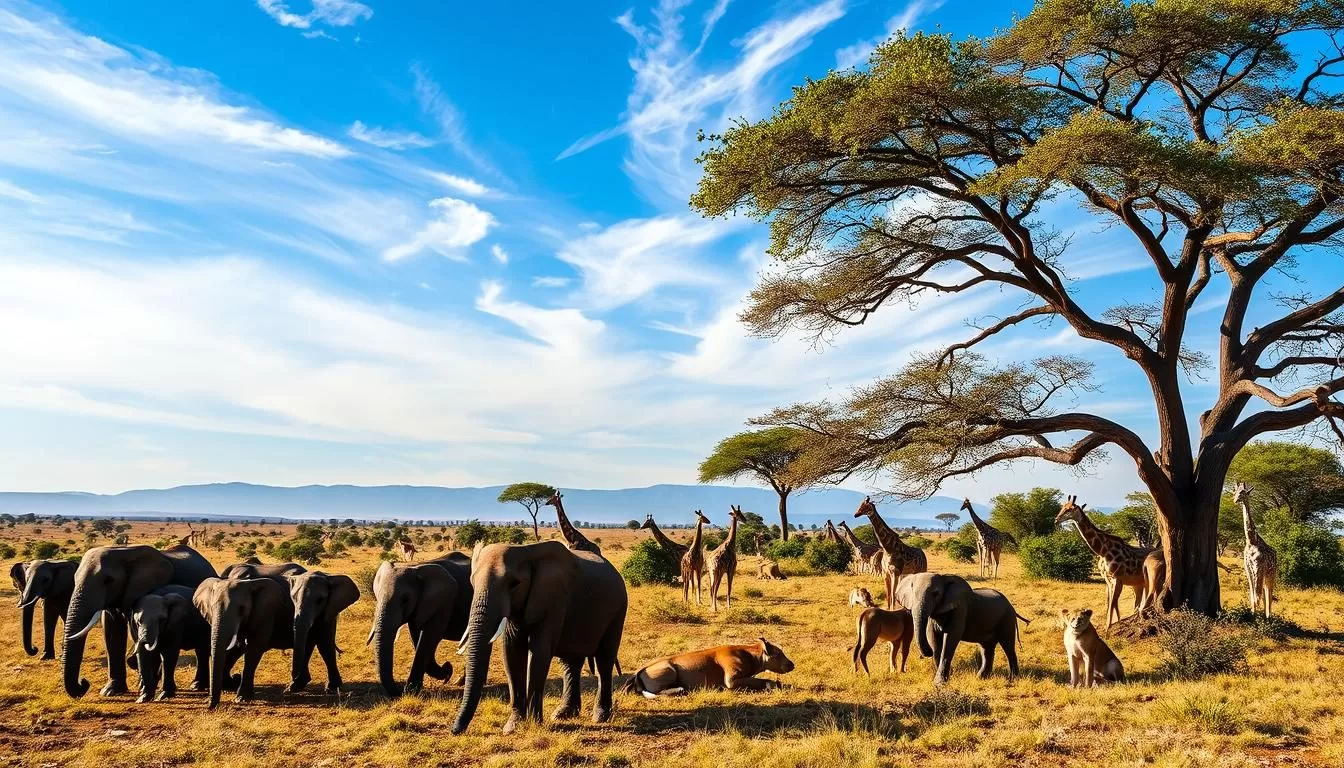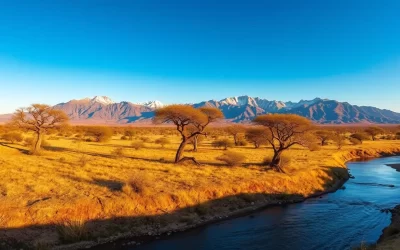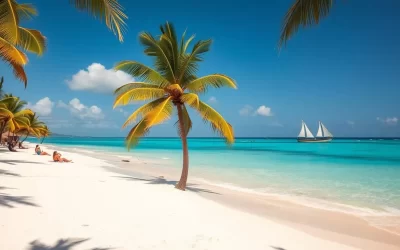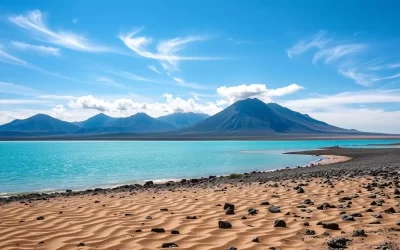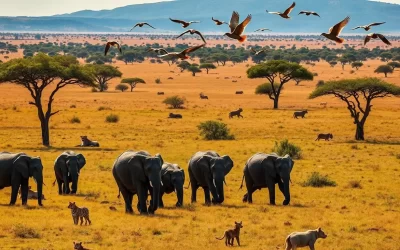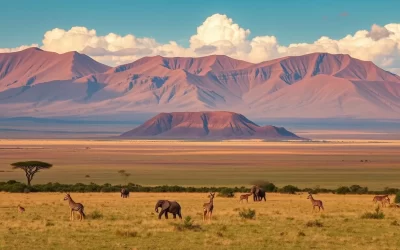✓ Accommodations✓ Flights✓ Rental Cars
Are you looking for a unique safari experience in Kenya? Samburu National Reserve is an excellent choice, offering an off-the-beaten-path destination with plenty of creature comforts. Located in northern Kenya, this reserve is known for its striking landscapes and diverse wildlife.
The reserve is home to the rare “Samburu Special5,” featuring unique northern species such as the gerenuk, Somali ostrich, and Grevy’s zebra. With its compact and accessible terrain, Samburu National Reserve provides excellent game viewing opportunities. You can enjoy a range of activities, from cultural experiences with the local community to adventure activities like camel safaris.
Whether you’re a seasoned traveler or just looking for a new adventure, Samburu National Reserve is a must-visit destination for an unforgettable safari experience.
Discovering Samburu National Reserve
Samburu National Reserve is a hidden gem in Kenya’s vast array of wildlife reserves, offering an unspoiled safari experience. Located on the banks of the Ewaso Nyiro River, the reserve is a sanctuary for a diverse range of wildlife.
Location and Landscape
Nestled in the northern part of Kenya, Samburu National Reserve is characterized by its semi-arid landscape, comprising acacia woodlands, thorny scrublands, and open grasslands. The Ewaso Nyiro River, which runs through the reserve, is a lifeline for the wildlife, especially during the dry seasons. The landscape is dotted with rocky outcrops and volcanic hills, adding to the reserve’s natural beauty.
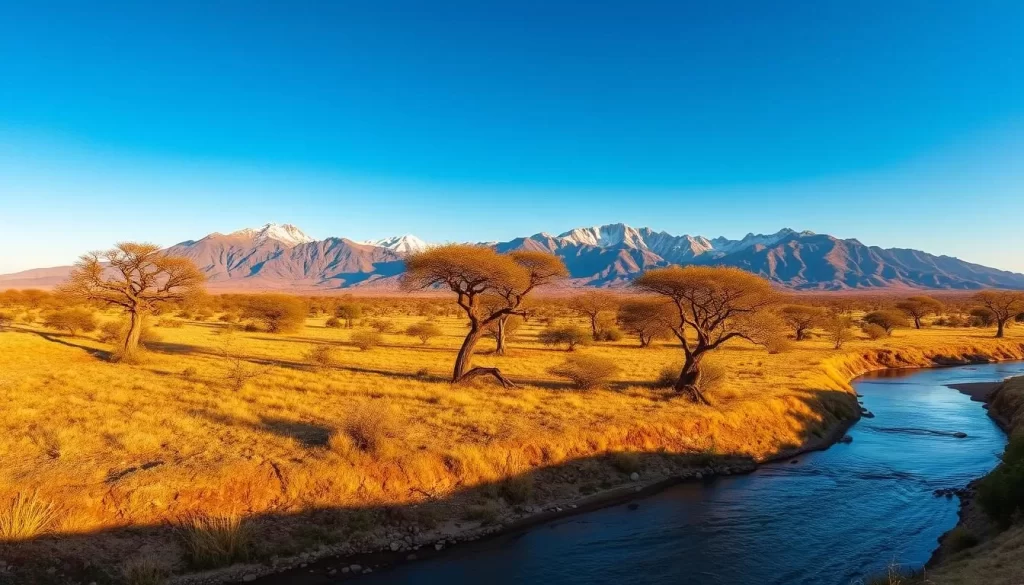
Why Samburu Stands Out from Other Kenyan Parks
Unlike more famous Kenyan parks like the Masai Mara or Amboseli, Samburu National Reserve remains relatively uncrowded, even during peak safari seasons. This exclusivity offers a more intimate wildlife viewing experience. The reserve is home to unique wildlife adaptations, including the “Samburu Special5,” which have evolved to thrive in this semi-arid environment.
| Features | Samburu National Reserve | Masai Mara |
|---|---|---|
| Crowd Level | Low | High during migration |
| Wildlife Adaptations | Unique “Samburu Special5” | Diverse, but more common species |
| Safari Experience | Exclusive and serene | Popular and often crowded |
Visiting Samburu National Reserve provides an authentic safari experience, with fewer vehicles at wildlife sightings, allowing for a more natural observation of animals in their habitat. The cultural dimension adds another layer of uniqueness, as the reserve is named after and home to the Samburu people, whose traditional way of life can be experienced through cultural visits.
The Samburu Special 5: Unique Wildlife Encounters
The Samburu Special 5 represents a group of extraordinary animals that you can encounter in Samburu National Reserve. These unique species have adapted to the harsh conditions of the reserve, making them a fascinating sight for wildlife enthusiasts.
Gerenuk (Giraffe Gazelle)
The Gerenuk, also known as the Giraffe Gazelle, is a remarkable antelope species known for its long neck and legs. It stands out due to its ability to stand on its hind legs to reach high branches.
Somali Ostrich
The Somali Ostrich is a large flightless bird that is native to the arid regions of East Africa. It is known for its powerful legs and strong running ability.
Grevy’s Zebra
Grevy’s Zebra is the largest species of zebra and is distinguished by its narrow stripes. It is considered endangered due to habitat loss and poaching.
Reticulated Giraffe
The Reticulated Giraffe is a subspecies of giraffe known for its distinctive coat patterns. It roams the open plains and woodlands of Samburu.
Beisa Oryx
The Beisa Oryx is a majestic antelope species perfectly adapted to Samburu’s arid conditions. Both male and female Beisa Oryx possess impressive scimitar-shaped horns that can reach nearly three feet in length.
These animals are a highlight of any visit to Samburu National Reserve, showcasing the wildlife diversity of the area. The Beisa Oryx, with its impressive horns, is a notable example of the unique wildlife encounters available.
Game Drives in Samburu National Reserve
Join a guided game drive in Samburu National Reserve for an immersive experience amidst Kenya’s most remarkable wildlife. The reserve is known for its unique species and stunning landscapes, making every game drive an adventure.
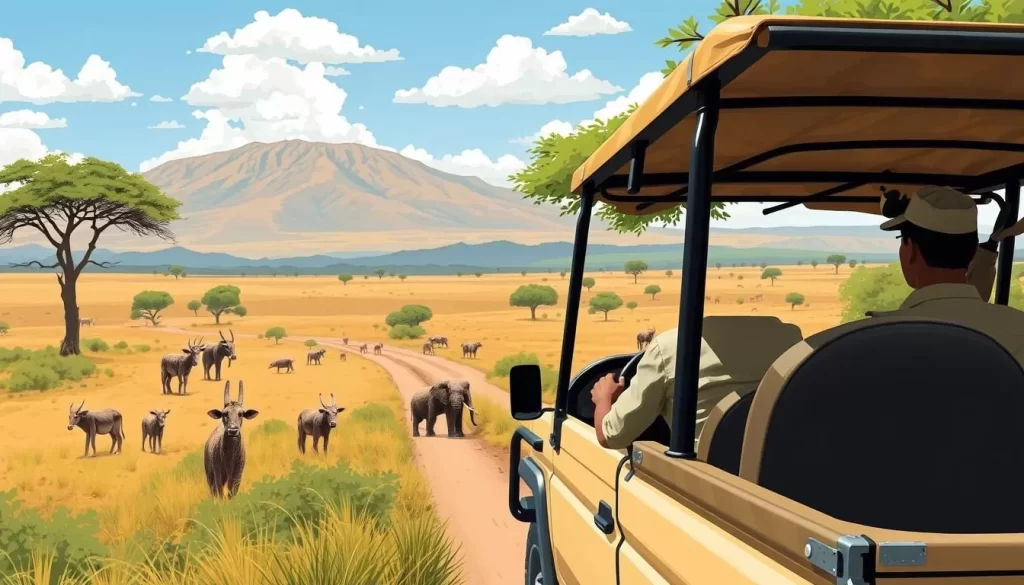
Morning Game Drives
Morning game drives in Samburu National Reserve are a great way to start your day, with the cool morning air and the golden light of sunrise creating a perfect setting for wildlife viewing. You’ll have the chance to spot a variety of animals, from the Reticulated Giraffe to the Beisa Oryx, as they begin their daily activities.
The morning is also an excellent time for safari enthusiasts to capture memorable photographs, with the soft light enhancing the colors and textures of the savannah.
Evening Game Drives
Evening game drives offer a different experience, with the temperature dropping and the animals becoming more active as the day cools down. This is a great time to witness the big cats on the prowl, as they prepare for their nocturnal hunts.
The atmosphere during the evening drives is serene, with the setting sun casting a warm glow over the reserve, making it an ideal time for reflection and connection with nature.
Night Game Drives
Night game drives in Samburu reveal a completely different side of the reserve. Using specialized spotlights with red filters, your guide will help you spot elusive nocturnal species.
Key highlights include:
– Glimpses into the secretive world of nocturnal wildlife that remains hidden during the day.
– The chance to witness big cats on the hunt, as they are primarily nocturnal hunters.
– Spectacular stargazing opportunities, with the night sky and unblemished Milky Way.
Note that night game drives are typically permitted in private conservancies bordering Samburu National Reserve.
The Ewaso Nyiro River Experience
The Ewaso Nyiro River is the lifeblood of Samburu National Reserve, offering an unforgettable experience for visitors. This river is not just a watercourse; it’s a vibrant ecosystem that supports a wide variety of wildlife and bird species.
Wildlife Viewing Along the River
The Ewaso Nyiro River provides a perfect setting for viewing a diverse range of wildlife. As you explore the riverbanks, you’re likely to spot a variety of animals, from large elephants to nimble antelopes, all drawn to the river’s water. The river’s presence creates a haven for many species, making it an ideal spot for wildlife enthusiasts.
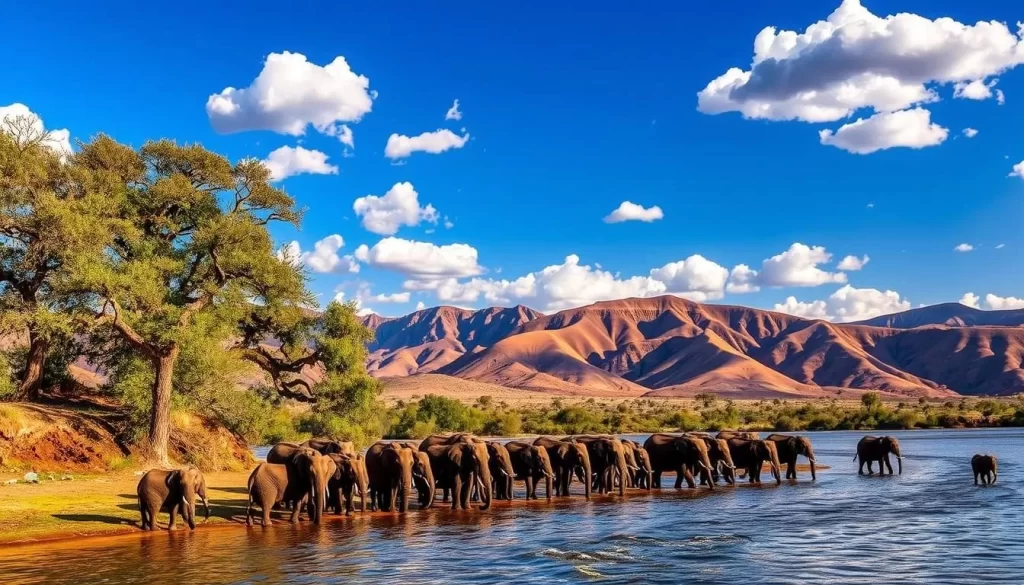
Bird Watching Opportunities
Samburu National Reserve is a bird watcher’s paradise, boasting over 450 recorded species. The Ewaso Nyiro River creates a vital habitat for many water-dependent bird species, including kingfishers, herons, and the striking vulturine guinea fowl. The reserve’s varied habitats also support a diverse range of raptors, such as martial eagles, secretary birds, and several vulture species.
- The reserve is home to over 450 recorded bird species, ranging from common residents to rare migrants.
- Specialized arid-land birds like the Somali bee-eater and the northern Kenya endemic Williams’s lark make Samburu exciting for serious birders.
- Early mornings along the river and in the acacia woodlands offer the best bird watching experiences.
Cultural Visits to Samburu Villages
Immerse yourself in the vibrant culture of the Samburu people through guided village tours.
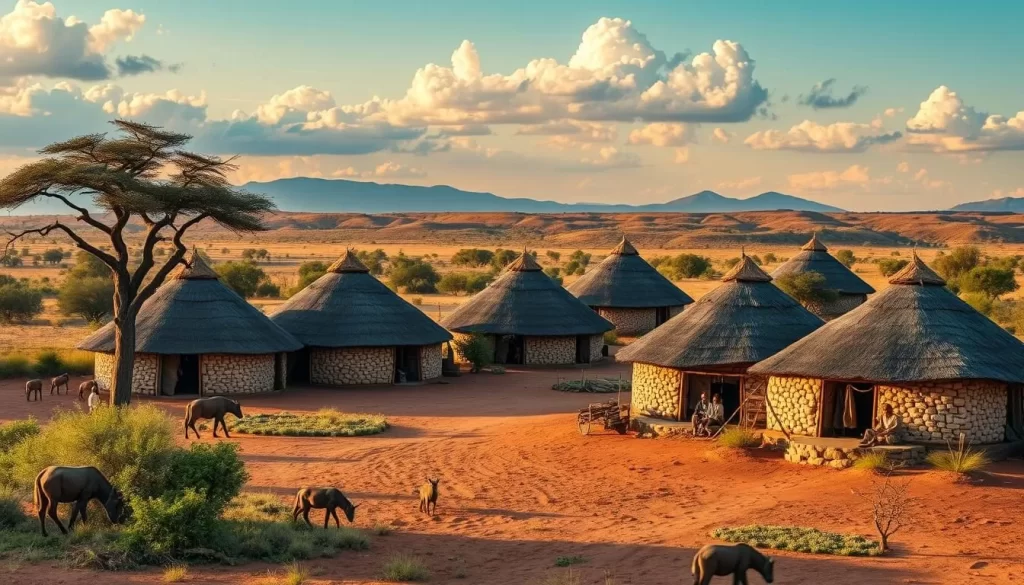
The Samburu community is known for its distinct cultural practices, which differ significantly from other Kenyan tribes like the Maasai. One of the unique aspects of Samburu culture is their use of camels, introduced by Arabian traders, which thrive in the semi-desert environment.
Learning About Samburu Traditions
During your cultural visit, you will have the opportunity to learn about the Samburu way of life. The Samburu people are known for their nomadic lifestyle, heavily reliant on their livestock such as cattle, goats, and camels. Understanding their relationship with these animals provides valuable insights into their daily life and traditions.
The Samburu have a rich cultural heritage, with traditions passed down through generations. You can expect to see traditional Samburu homes, known as manyatta, which are constructed using local materials.
Participating in Cultural Activities
Participating in cultural activities with the Samburu people offers an immersive experience that goes beyond observation. You may be invited to join in traditional dances, where Samburu warriors perform impressive jumping movements while women create rhythmic singing accompanied by intricate bead collar movements.
- Many cultural visits include demonstrations of traditional skills such as fire-making, beadwork crafting, or building traditional manyatta homes using local materials.
- Learning about the Samburu’s relationship with their livestock provides insights into their nomadic way of life and how they’ve adapted to the harsh northern Kenyan environment.
- These participatory experiences often conclude with an opportunity to purchase authentic Samburu crafts directly from artisans, supporting the local community while acquiring meaningful souvenirs of your visit.
By engaging in these cultural activities, you not only gain a deeper understanding of the Samburu way of life but also contribute to the local economy through your participation and purchases.
Camel Safaris Through the Scrubland
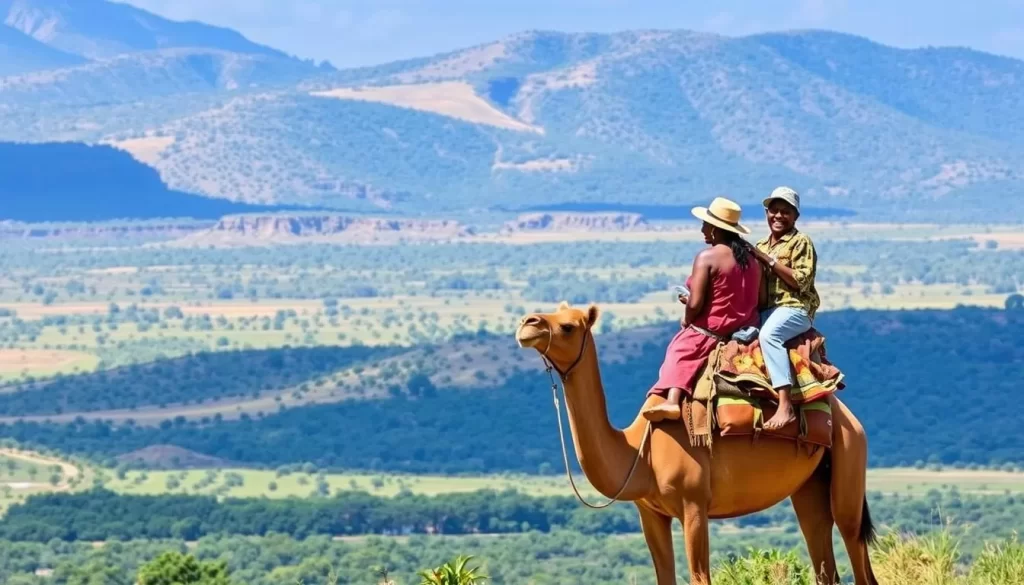
Embark on a camel safari through Samburu’s scrubland for an unforgettable experience. Camel safaris are very versatile, offering options ranging from a two-hour round trip with sundowners to longer, overnight adventures that include fly camping in the bush.
What to Expect on a Camel Safari
On a camel safari, you can expect to traverse the drier plains and gentle hills away from the Ewaso Nyiro River, where the terrain is easier for camels to navigate and wildlife viewing opportunities are excellent. Many lodges offer versatile camel safari options, from short excursions for first-timers to full-day adventures that include bush meals in scenic locations.
Best Routes and Times
The best times for camel safaris are early morning (6-9 AM) and late afternoon (4-6 PM), offering cooler temperatures, active wildlife, and beautiful lighting for photography. The dry season, from June to September and December to March, provides the best conditions, with clearer trails and more concentrated wildlife around water sources.
Helicopter Safaris: A Bird’s Eye View

Take to the skies and enjoy a bird’s eye view of Samburu’s stunning landscapes and diverse wildlife on a helicopter safari. This luxury experience offers a unique perspective on the Samburu National Reserve, allowing you to witness the beauty of the Kenyan wilderness from a new angle.
Aerial Views of Samburu’s Landscape
The helicopter safari provides an unparalleled experience, giving you a broad view of the reserve’s vast landscapes. You’ll see the Ewaso Nyiro River snaking through the terrain and the varied habitats that support a rich array of wildlife.
Exclusive Landing Experiences
Helicopter safaris in Samburu include exclusive landing experiences. You can land on the sacred Samburu mountain, Ol Donyo Sabachi, for a champagne breakfast with panoramic views. Other experiences include sundowner landings on isolated kopjes and visits to remote Samburu communities.
- Exclusive landings in remote, otherwise inaccessible locations
- Landing on Ol Donyo Sabachi for a champagne breakfast
- Sundowner experiences on isolated kopjes
- Visits to remote Samburu communities
- A premium experience that provides access to Samburu’s most remote landscapes in a short time
The cost for a one-day helicopter safari for a group of 1 to 5 people is typically in the range of $5,000 to $7,000.
Where to Stay in Samburu National Reserve
From luxury lodges to budget-friendly options, Samburu National Reserve has a wide array of accommodations to suit every kind of traveler. Whether you’re looking for comfort, adventure, or a mix of both, your stay here can be tailored to your preferences.
Luxury Lodges
For those seeking a luxurious experience, Samburu National Reserve offers high-end lodges that provide top-notch amenities and services. These lodges often feature elegantly designed rooms, fine dining options, and exceptional service. One such example is a lodge that offers stunning views of the surrounding landscape and easy access to wildlife viewing areas.
Tented Camps
Tented camps in Samburu offer a more rustic and immersive experience, blending comfort with the raw beauty of nature. These camps are often set in prime locations, allowing for intimate wildlife encounters and a deeper connection with the natural environment. Lion’s Cave Camp is a notable example, with its unique architecture and serene setting by the river.
Budget-Friendly Options
For travelers on a tighter budget, Samburu National Reserve and its surrounding areas offer affordable accommodations that don’t compromise on the essential experiences. Options like Samburu Simba Lodge provide comfortable rooms and basic amenities at a lower cost, making it possible for more people to enjoy the beauty and wildlife of Samburu.
Regardless of where you choose to stay, Samburu National Reserve promises an unforgettable experience with its rich wildlife, stunning landscapes, and warm hospitality. Take your time to select an accommodation that fits your needs and enjoy the best of what Samburu has to offer.
Best Time to Visit Samburu National Reserve
When planning your trip to Samburu National Reserve, understanding the best time to visit is crucial for a memorable experience. The reserve is open throughout the year, but the experiences vary significantly depending on the season.
Dry Season (July-October)
The dry season, from July to October, is considered one of the best times to visit Samburu National Reserve. During this period, the weather is generally dry and sunny, making it ideal for wildlife viewing. The dry conditions cause animals to congregate around water sources, such as the Ewaso Nyiro River, making them easier to spot.
The dry season is also a great time for bird watching, as many bird species are more active during this time. The clear skies and comfortable temperatures make it an excellent period for safari activities.
Green Season (November-April)
The green season, which spans from November to April, offers a different but equally rewarding experience. The gentle rains during this period transform the landscape into a lush, verdant paradise. This season is ideal for wildlife photography, as the fresh grasses and flowering plants create a beautiful backdrop.
During the green season, migratory bird species arrive from Europe and northern Africa, joining the resident birds to create a spectacular diversity of avian life. The reduced number of safari vehicles during this shoulder season means more exclusive sightings.
| Season | Characteristics | Activities |
|---|---|---|
| Dry Season (July-October) | Dry and sunny weather, animals congregate around water sources | Wildlife viewing, bird watching, safari |
| Green Season (November-April) | Lush landscape, gentle rains, fresh grasses and flowering plants | Wildlife photography, bird watching, safari |
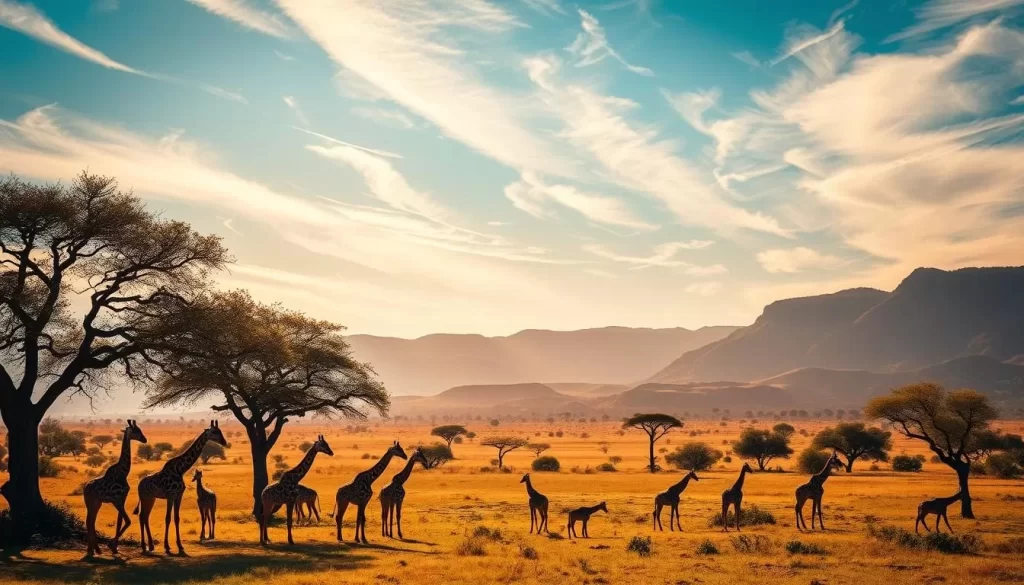
Combining Samburu with Other Kenyan Destinations
Enhance your Kenyan safari by visiting Samburu National Reserve in conjunction with other notable wildlife areas. This approach allows you to experience the country’s diverse landscapes, wildlife, and cultures.
Nearby Reserves: Buffalo Springs and Shaba
For a more immersive experience, consider visiting the nearby reserves of Buffalo Springs and Shaba, which are adjacent to Samburu National Reserve. These reserves offer similar wildlife viewing opportunities, including the Special Five animals unique to the region. You can easily move between these reserves, creating a comprehensive safari experience.
| Reserve | Notable Wildlife | Experience |
|---|---|---|
| Buffalo Springs | Gerenuk, Somali Ostrich | Game drives, bird watching |
| Shaba National Reserve | Grevy’s Zebra, Reticulated Giraffe | Game drives, camel safaris |
Extended Safari Itineraries
You can also combine Samburu with other Kenyan destinations to create an extended safari itinerary. A popular combination is with the Masai Mara National Park, where you can witness the Wildebeest Migration. Alternatively, visiting Sera Wildlife Conservancy allows you to track rhinos on foot, accompanied by expert guides.
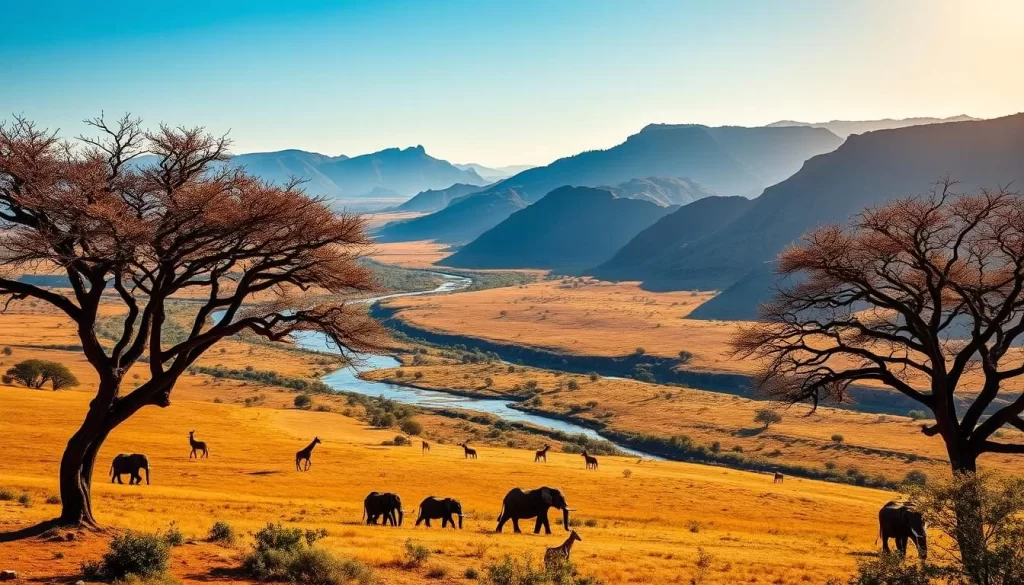
Planning Your Unforgettable Samburu Safari Experience
## Planning Your Unforgettable Samburu Safari Experience
To make the most of your visit to Samburu National Reserve, it’s crucial to plan your safari experience with care.
When planning, consider allocatingat least three nightsto fully experience the reserve’s unique wildlife, landscapes, and cultural opportunities. You can either fly or drive to Samburu. Flying from Nairobi takes just under an hour, offering spectacular aerial views, while the six-hour drive allows you to experience Kenya’s changing landscapes and potentially visit other parks along the way.
Choose accommodations that match your preferences and budget, fromluxury lodges with private plunge poolstoauthentic tented campswhere elephants wander through at night. Include a variety of activities in your itinerary, such as cultural visits, camel safaris, and guided walks, to add different dimensions to your Samburu experience. Consider visiting during the shoulder seasons for good wildlife viewing with fewer visitors.
The above is subject to change.
Check back often to TRAVEL.COM for the latest travel tips and deals.
